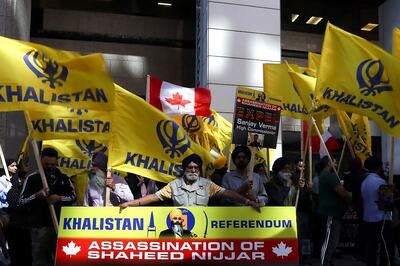
views
In a very significant move last year in May, the Supreme Court of India put the 152-year old sedition law, defined under Section 124A of the Indian Penal Code (IPC), into abeyance till the Union Government reconsiders the provision.
The apex court in its order had stated, “We hope and expect that the State and Central Governments will restrain from registering any FIR, continuing any investigation or taking any coercive measures by invoking Section 124A of IPC while the aforesaid provision of law is under consideration.”
With this order it was thought that Sedition would cease to be an offence as defined under Section 124A of the IPC.
However on June 2, 2023 Law Commission of India in its 279th report titled ‘Usage of the law of Sedition’ not only recommended retaining Section 124A but also suggested increasing the jail term in sedition cases from a minimum of three years to seven years.
While the Law Commission suggested retaining the Sedition Law, Union Law Minister Arjun Ram Meghwal through a series of tweets said that “the law commission report on Sedition is one of the steps in the extensive consultative process. The recommendations made in the report are persuasive and not binding. Ultimately, the final decision will be taken only after consulting all the stakeholders.”
Now, as the government begins to consult with various groups and individuals, as recommended by the Law Minister, it is important to take a fresh look at the history of the Sedition Law:
What does Section 124A Say?
“Whoever by words, either spoken or written, or by signs, or by visible representation, or otherwise, brings or attempts to bring into hatred or contempt, or excites or attempts to excite disaffection towards, the Government established by law in [India], shall be punished with 5[imprisonment for life], to which fine may be added, or with imprisonment which may extend to three years, to which fine may be added, or with fine.”
When was Sedition law enacted?
It was introduced in 1870 and was not a part of Thomas Macaulay’s original draft of Indian Penal Code (IPC) 1860. It was introduced with a primary aim of suppressing ant-British voices.
First case in the pre-independence era
The first important case under sedition was Queen-Empress versus Jogendra Chunder Bose filed in 1891. A case under the sedition law was registered against the editor, manager, and printer of the Bengali magazine as it was critical of British government’s Age of Consent Act that raised the age of consent for sexual intercourse. There was no conviction in this case.
First case in the post-independence era
After the constitution of independent India came into force in three judgments, high courts declared the Sedition law unconstitutional and void. It was only in 1962 that the apex court restored its validity.
Tara Singh Gopi Chand was the first case related to Sedition in independent India that came for adjudication before the Punjab and Haryana High Court. The court declared the Sedition law as void. Part of the judgment reads,”There can be no dispute that Section 124A is a restriction on the freedom of speech and expression which is guaranteed to all citizens by Article 19 of the Constitution”.
In yet another case titled Sabir Raza which was decided in 1958, the Allahabad High Court made an important observation. The judgement stated, “Disaffection towards the Government may be advocated. Exciting such a feeling towards the polity or organised form of Government established by the Constitution is punishable under the Section, but as in the case of public order, it is a far cry to say that the security of the State requires a restriction on exciting such a feeling”.
The judgement made it clear that the security of the State would be considered under the threat “only if there is a threat to the system of government established by the Constitution” and “it is threatened neither by a threat to change the persons holding the offices of the President, the Governor and the Minister nor by a mere exciting of a feeling of hatred, contempt or disaffection towards the system of government.”
The same year in the hate speech case titled Ram Nandan versus State, the three-judge bench of the Allahabad High Court held the sedition law as ultra vires of Article 19(1) of the Constitution.
What the Constituent assembly said about the Sedition law
KM Munshi, who was one of the most prominent members of the Constituent Assembly can be credited for getting sedition dropped from the Constitution.
On 1 December 1948, while arguing against the inclusion of ‘sedition’ as a reasonable restriction on the freedom of speech and expression, KM Munshi said that sedition by its definition has been very simple but “in practice, it has had a curious fortune.”
He argued how a century-and-a-half ago, holding a meeting or conducting a procession was considered sedition. He explained how the sedition law “was sometimes so widely construed” that in a particular case, criticism of a district magistrate was argued to be taken as act sedition.
An important Sedition case: Kedar Nath Singh Vs State of Bihar
This case was decided in 1962 where a man named Kedar Nath Singh who was member of a political party named Forward Communist Party while criticising the ruling Congress party said, “The people of India drove out the British from the country and elected these Congress goondas to the gaddi. As we drove out the British, we shall strike and drive out these Congress goondas as well.”
He further added, “Revolution will come and in the flame of which, capitalists, zamindars and Congress leaders will be reduced to ashes, and on their ashes will be established a government of the poor and the downtrodden people of India”.
His call for overthrow of a democratically elected government attracted sedition charges and he was convicted for Sedition by the trial court and his conviction was upheld by the High Court. The Supreme Court while upholding the validity of the Sedition law provided certain safeguards against its misuse.
In its judgement the apex court stated: “However strongly worded, expressing disapprobation of actions of the government, without exciting those feelings which generate the inclination to cause public disorder by acts of violence would not attract the penal offence”.
Supreme Court enunciated proper guidelines
In a case titled Sanskar Marathe vs The State Of Maharashtra the Supreme Court issued certain guidelines to be followed by police while invoking Section 124 A of the IPC. The pre-conditions enunciated by the apex court was
“The words, signs or representations must bring the government (Central or State) into hatred or contempt or must cause or attempt to cause disaffection, enmity or disloyalty to the government and the words/signs/representation must also be an incitement to violence or must be intended or tend to create public disorder or a reasonable apprehension of public disorder; (ii) Words, signs or representations against politicians or public servants by themselves do not fall in this category unless the words/signs/representations show them as representative of the government; (iii) Comments expressing disapproval or criticism of the government with a view to obtaining a change of government by lawful means without any of the above are not seditious under Section 124A.”
The most recent case of Sedition
In 2021, environment activist Disha Ravi was charged with sedition for allegedly editing a toolkit related to the ongoing farmer protest last year. While quashing the FIR, the apex court held that “sedition cannot be invoked to minister to the wounded vanity of the government.”
Now, with the Law Commission recommending for retaining the Sedition law, it will be upon the executive to decide whether this law— which has a long history of abuse and very low rate of conviction — serves any purpose and whether it should be retained or not.




















Comments
0 comment